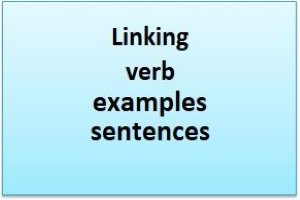Linking verb examples sentences:
A linking verb is one that links a sentence’s subject to a word or phrase that describes or labels the subject.
The word “to be” is the most commonly used linking verb. Other linking verbs include sense verbs (such as “look,” “sound,” “smell,” “taste,” and “feel”), turning into verbs (such as “blow,” “run,” and “come”), and shows possession verbs. (such as “have,” “own,” and “belong”).
A linking verb connects (links) the subject of the sentence to information about that subject. Action is not described by linking verbs. When linking verbs are used, the sentence structure will be as follows
SUBJECT + LINKING VERB + INFORMATION ABOUT SUBJECT (noun)(verb)(adjective, noun, or complement)
Because some verbs never describe an action, these verbs are ALWAYS linking verbs. In some sentences, other verbs can be linking verbs, while in other sentences same verbs can be action verbs.
List Of Verbs That Are ALWAYS Linking Verbs:
The following verbs are always used as linking verbs
To be (was, were, is, am, are, has been, have been, had been, will have been, is being, are being, was being, etc.)
To become (has become, have become, become, became, will have become, becomes, had become, will become, etc.)
To seem (has seemed, had seemed, seeming, seemed, seems, have seemed, is seeming, were seeming, was seeming, will seem, are seeming).
Exmples in sentences:
“The book is red.” ‘Is’ is a linking verb that connects the subject (book ), to information about that subject (that it is red).
“The children are running.” Here ‘Are’ links the subject, children, to the word ‘running’ (Running is the information about the children.)
“The neighbours seem unhappy.” ‘Seems’ is linking the subject, neighbours, with the word unhappy which is the main information about the neighbours.
List of linking verbs:
Forms of “be”:
| Is | Can be | May be |
| Are | Could be | Might be |
| Am | Will be | Must be |
| Was | Would be | Has been |
| Were | Shall be | Have been |
| Should be | Had been |

